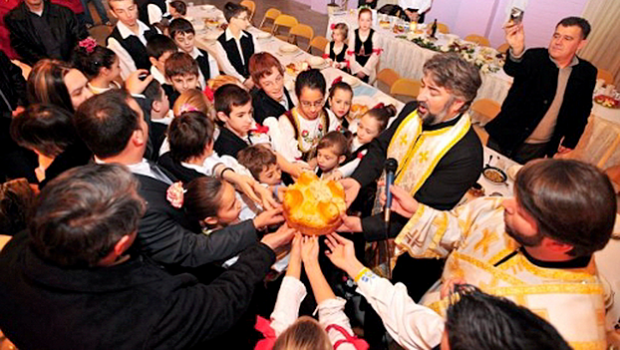
Slava is a feast honoring a patron saint similar to the Thanksgiving. According to a legend, Slava was indoctrinated by the church after the custom caught on in the nation. It started as a cunning plan of rebellious slaves to spite the Ottoman rule over the Balkan region. In the ancient days when Ottomans were on a warpath conquering Europe, non-Islamic population was enslaved for 500 years. To pacify the Balkan population and ensure that there won’t be a religious uprising, Ottomans granted their slaves to practice their religious beliefs. No other gathering was allowed as Ottomans feared the warmongering of the slaves. This given right was exploited by the rogue slaves that started using religion as pretext to form gatherings and warmonger against the Ottomans – and that’s how Slava was born. Word Slava also means Glory, but depended on the context and a sentence structure it signifies the religious celebration.
Slava is considered a very unique tradition even for the Orthodox Christianity in general, as it is mostly reserved for the Balkan region. Originally, Slava lasted for three consecutive days where second day was marked as a main day dedicated to a patron saint and the other two were usually used for socializing and family bonding. The most celebrated Godly protector of the household among Serbs is Saint Nikola or better known as Saint Nicholas in Catholicism. Because people traveled with horses or cattle in those ancient times and traveling could last for days, celebration had to last for three days so guests could rest from a long voyage.
In the modern times, Slava lasts for one day, but Serbs like celebrating, so we have many Holy Days, some families have none, some have a dozen, but a norm is to have 3. When I came to talk about the number 3, I must emphasize the magical essence of that number. Your thumb, pointer finger and middle finger represent the Holy Trinity of the Father, the Son and the Holy Ghost, but when they touch together they symbolize the Unity. When Serbs lift the first 3 fingers in the air, it symbolizes the freedom and a unity of the people under one God. We do many things three times. When we meet friends, male or female, we kiss on the cheek three times; we bless ourselves three times, spit three times so Devil won’t hear our fearful thoughts and many other things. Also, speaking of the blessings – Self blessing is performed by right hand (never left). To correctly do a blessing, one must gather its fingers like picking up the salt or that dumb Italian hand meme, and touch his forehead, then in a straight line touch his belly button, then touch the top of their right shoulder and complete the blessing by touching the top of the left shoulder.
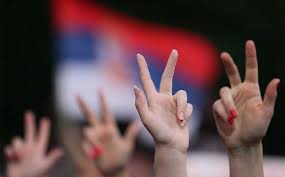
Serbian “freedom” hand sign
There are unwritten rules of how Slava is properly conducted, so I’ll describe a most generic tradition that may vary from a family to family, from town to town.
Reception
Upon coming at the door of the host, pleasantries are exchanged, warm smiles, hugs and three kisses. In the old days children were given apples or a cube of sugar, because times were harsh, where in the modern days people usually bring a bottle of wine, a box of cookies and a pack of coffee (100 g of Arabica type coffee).
The guests are welcomed with a dish we call “Žito”. Žito is boiled wheat sweetened with sugar and sprinkled with ground walnuts. Proper way of eating Žito is including a blessing oneself before taking a spoonful of the dish. A glass of water is offered along with the tasting of Žito to wash down the sweetness from tongue, and then Rakia is being poured along with a cup of coffee. Lively conversation is led before the time comes for a feast.
After all of the guests have arrived, they all move to the Guest Room. Guest Room is a space decorated for festivity and it is mostly used only when some celebration is being held. It sounds weird, but every Serbian house has one of those rooms. When everybody is seated and ready for a feast to start, a religious part is taking place at the long table.
Religious part
A man of the house that sits in the “forehead” of the table asks for his friends and family to stand up for a ceremonial breaking of the bread. This ceremony symbolizes the Last Supper of Jesus Christ. Everybody must stand as in Orthodox Christianity, we consider ourselves the free people, and free people bow to no one. Orthodox Christianity also teaches us that if God made us to his image, then I must be looking like him, therefore I am him and he is me, and I not need to bow or pray to myself. When we pray, we pray to the patron Saints of our house.
Host blesses himself, then he lights up a candle. After that, he takes the cresset filled with burning coal and puts in a piece of pine resin Serbs use and incense. Host makes three circles with the cresset around the table and everybody is blessing themselves, while a prayer is being recited. After that is being done, it is time to cut the “Kolač”. Kolač roughly translates to Cake, but it’s not a cake. Kolač is slightly sweetened bread, specially made for a feast and decorated with religious motives such are a cross, a rose and braids. Kolač is symbolically representing Jesus Christ. The host uses the point of the knife to bless the Kolač in the shape of a cross while chanting “In the name of the Father, the Son and the Holy Ghost, Amen”, then he slices the Kolač in four pieces. Kolač is held “up side, down” where small drops of wine are being poured on those pieces with the same chant repeated. Now the Kolač resembles the embodiment of the Jesus Christ. After that, Kolač is raised in the air where everybody present – needs to put their hand on it. At this point, Kolač is still held to original form as the bread is being manually spanned several times in the air along with the chant “God bless us”. Now Kolač gets broken in half where bottoms touch each other. The following routine is performed only by two people. After every spin, the host says “God is between us” meaning that Jesus is present between them, and a reply follows “Indeed, may it be so”. The number of spins… Yes, it’s three. After the reply, they both kiss the bread in sign of respect for the God and sign of their love for the God. I mean, in what other way you can prove your love if not by a kiss? That’s where the soul of Christianity lies.
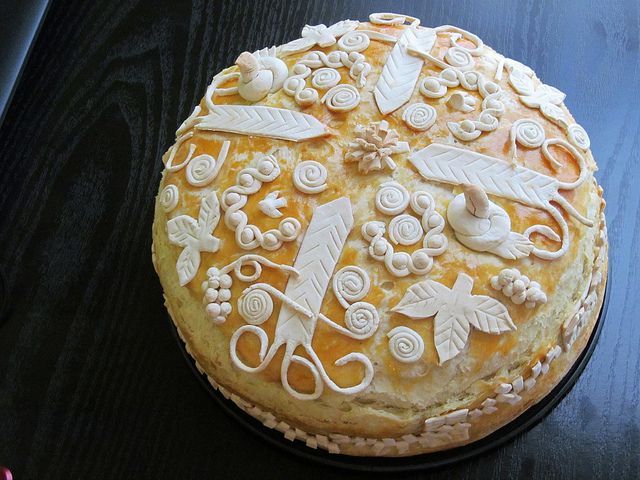
Traditional “Kolač”
For the next section in ritual of breaking bread, four people intertwine their hands making a cross where everybody is holding one half of the Kolač. Here is the final stage of breaking bread, but after the breaking, whoever holds the quarter of the Kolač must kiss it and raise it above his head. The whole ceremony is followed by a choir of “Amen’s” and self-blessing.
The feast
There are two types of feasts: Masna (greasy) and Posna (not greasy). The difference in-between those two is rather simple. For a greasy Slava, we can use any meat and any product of an animal, whereas to a Posna Slava, we may only do strictly vegan (not even vegetarian) course with addition to use fish and fish products. When Masna Slava is being prepared, we cook on pig’s fat, but in the Posna we use sunflower oil or if fasting, cook only on water. How to know when it is Masna and when Posna Slava, you can just see the days in the week. Posna Slava is prepared only if the date marked with the red letter of a patron Saint comes in Wednesday or Friday. Those two are reserved for fasting in Orthodox Christianity. Now, you might get surprised by having Masna Slava on those days if family hosting the feast is not that religious and keen on fasting. I guess, everybody prays to God in their own way, and there are no strict rules of how can you pray to God.
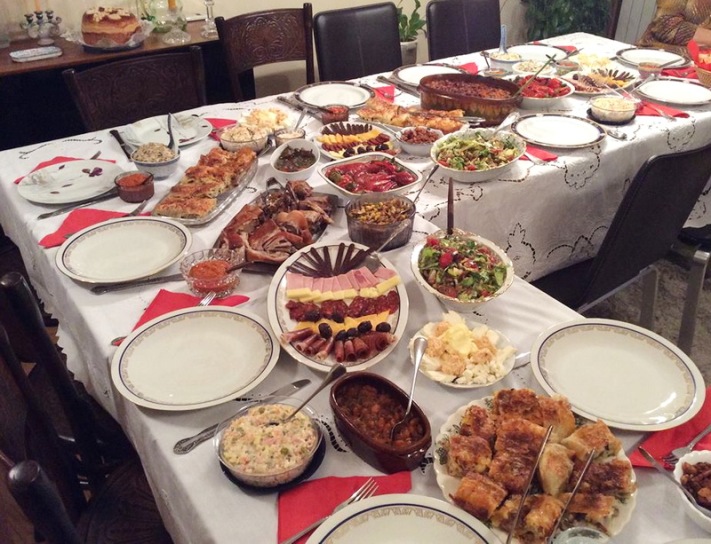
The first wave of the feast
It is also important to say that the feast happens in waves.
The first wave is cold appetizer or better known as “meze”. You can expect a neatly decorated platter with variations of smoked meat, various types of cheese, boiled eggs, and rolls made of cream cheese, ham and bread. Along with that plate of snacks, other things will accompany it like: pickled peppers, light salads, žito, slices of tomatoes garnished with onions, pihtije (meat jelly), cucumber salad, cheese pie (banica), cornbread, many sort of pastries, sour cream milk (Heaven is made of it) etc.
Posna Slava is pretty much the same; just take out the meat products and dairy products. Also in add to the appetizers, we like putting the pihtije made from broad beans which has a similar taste to humus and overpowering aroma of garlic. Also you can add a potato pie (banica), cabbage pie (also banica), mushroom pie (you get the point, banica) or sour cherry pie (really?, banica).
Second wave is a soup or a similar dish we call čorba. Soup is traditionally made clear with chunks of noodles, where in Balkans we have soup, but we also have čorba. Čorba might be more familiar as a type of cream and thick soups. The variety of soups we serve may be “plain” (chicken mostly) soups to a meat soup and herbal/vegetable soups.
For Masna Slava, you may be offered to eat: lamb soup, beef soup, pig soup and creamy chicken soup.
For Posna Slava you would be treated with: potato soup, bead soup, cabbage soup, monk’s rhubarb soup or any other vegetable soup that is in season.
Third wave is main course where you can usually find more than two dishes to eat. Most people are already full with all that eating, but Slava goes on.
For Masna Slava you can expect: sarma (grinded meat rolled in cabbage leaves), stuffed peppers (grinded meat in peppers), meatballs in tomato soup or a wedding sauerkraut (layer of cabbage, layer of meat stacked to the top of the pot and boiled for several hours).
For Posna Slava you will most definitely be served with beans dish seasoned with garlic, fried potatoes with mushrooms aside, soy or pumpkin seeds stuffed peppers, boiled cabbage.
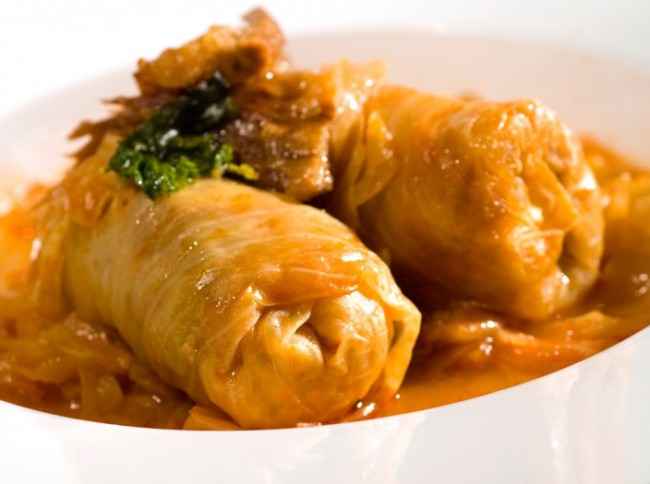
Serbian sarma
The fourth wave is reserved for dishes that rely on meat.
For Masna Slava, a tradition is to have a roasted pork, roasted lamb, various meat rolls or a Serbian type barbeque. Meat is usually accompanied by a cabbage salad or any other salad, because we like combining tastes and we eat our salads with meat.
For Posna Slava you can find smoked or fried fish, fish stew, grilled fish and a fish soup. Fishes we predominantly use are: catfish, atlantic mackerel, common carp, salmonids and merluccius merluccius fish that is most used. This segment is also accompanied by a salad of a seasoning. The most common salad to be served is potato salad (boiled and peeled potatoes with onions and spices).
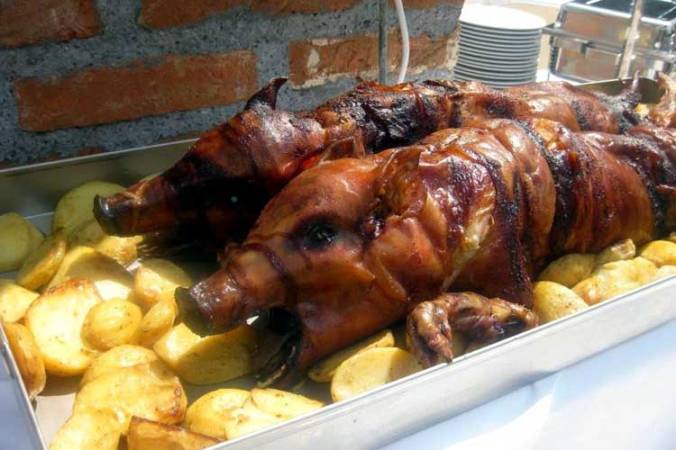
Roasted Pork
The fifth wave is desserts. Everybody had to survive through the endless line of plates in order to get to the sweetest part.
For Masna Slava, expect light summer cake with fruits such as raspberry, strawberry, blueberry or bananas. If fruits not in season, you will be surprised by chocolate cake, honey cake, jaffa cake and thousand more cakes different in ingredients.
For Posna Slava you would feast on small delights various in shapes, sizes and flavours.

Homemade baklava
For sixth wave of the feast you’ll get a cup of coffee, a toothpick and a round of conversation that often steer from talking about politics, switch to economy and gossips, make a turn over the war stories and end up recalling the past celebrations like weddings, baptism of the children, sending off a son to the military, recalling of the elders that passed their wisdom onto the younger generations and keeping the family and Slava safe.
It is also important to know that Slava evolved through time. In the old days, feast was made of simple and common dishes like fried potatoes, čorba, fried meat, whereas today, Sebs will make more bountiful feast. Religion is not at the highest peak among the Serbs and many practise religion in their own way, so even if Slava is a religious custom, Slava is considered more of an ethnic tradition. If you happen to be in Serbia and make friends there, expect to be called to a Slava. It is a custom to only once call a friend for a Slava where after that he is welcome to attend the celebration every year without an invitation. It is a rule that on the day of Slava, no body will be denied to enter the home nor he will be kept away from the food table. Open doors for everyone.
For more faster posts, you may click here: Facebook & Twitter.
Pingback: Nighttime blabbering 358 | Dronstad
Pingback: Night time blabbering 245 | Dronstad
Pingback: Night time blabbering 221 | Dronstad
Wow great post..u had me at feast but a really interesting read…everyday is a school.day…
LikeLiked by 1 person
😀 Indeed, people learn as long as they live. 😀
LikeLike
Pingback: Night time blabbering 118 | Dronstad
Pingback: Night time blabbering 137 | Dronstad
Pingback: Night time blabbering 136 | Dronstad
Pingback: Orthodox Christmas – Serbian style | Dronstad
Pingback: New Year’s battlegrounds Serbia | Dronstad
Pingback: Author Interview – Lior Gavra – “BitterSweet” (Contemporary Poetry) | toofulltowrite (I've started so I'll finish)
😱
Which means you are on a diet two months before AND after Slava….
😜😄🤗
LikeLiked by 1 person
A-haa, it seems you know about this ancient tradition. 😀 The truth is, it’s about the people and the family – not so much about the food. Seriously now, you’ve been to a slava? 😀
LikeLiked by 1 person
No, I haven’t… and seriously yes, I guess it’s about family and warmth… you explain that well 🤗🤗
LikeLiked by 1 person
Wow! That looks like a lot of food. Thanks for sharing this man and Merry Christmas.
LikeLiked by 2 people
Thanks Major. 😀 Saint Nikola’s day is today. I wish you were here to feast with me. 😀 About that Christmas, you’ll have to wait for January to congratulate me. 😀
LikeLiked by 1 person
Our pastor spoke about Saint Nikola on Sunday. His backstory is similar to Bruce Wayne. And ok enjoy your feast and working off the pounds when it’s complete 🙂
LikeLiked by 1 person
Wonderful traditions and the food looks amazing! Love the cake! Thanks for sharing.
LikeLiked by 2 people
You welcome. 😀
LikeLiked by 1 person